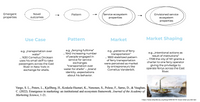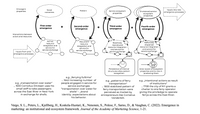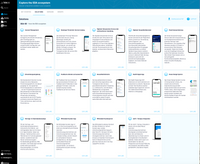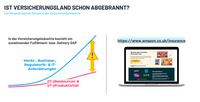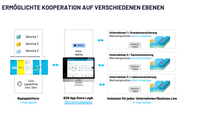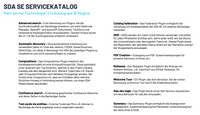"Der Tausch von digitalen Lösungen (Services; Fähigkeiten) ist der Handel des 21. Jahrhunderts; Plattformen sind die Boote der Eroberer"; Markus Warg, CIO.de
SDA Servicekatalog - Institutions
1. What are Institutions?
2. Why are Institutions at the core of social and economic interaction?
3. SDA and SDA Service Catalog
4. Practical Operationalization by SDA SE & onpier
1. What are Institutions?
Institutions are rules and structures shaping social and economic interaction.
Some definitions:
"Institutions constitute and generate regularized patterns of interaction by changing the costs and benefits associated with alternative actions and by making available options that would not be feasible to any one individual acting alone”
McGinnis, Michael D. (2013). Updated Guide to IAD and the Language of the Ostrom Workshop: A Simplified Overview of a Complex Framework for the Analysis of Institutions and their Development.
“Institutions are the rules of the game in a society or, more formally, are the humanly devised constraints that shape human interaction. In consequence they structure incentives in human exchange, whether political, social, or economic. Institutional change shapes the way societies evolve through time and hence is the key to understanding historical change.”
North, Douglass C. (1991). Institutions, Institutional Change and Economic. In: Сambridge.
“Institutions are the socially constructed (i.e., human-made) rules, norms and beliefs that provide stability and meaning to social life by constraining and enabling collective action (Scott, 2014). In other words, institutions can be understood as the implicit and explicit ‘rules of the game’ (North, 1990), which coordinate resource integration and service exchange among actors (Edvardsson et al., 2014; Vargo and Lusch, 2016). Additionally, institutions frame the contexts of social interaction and exchange, as well as shape the interests and identities of actors participating in value cocreation” (Vargo et al., 2018).
Vargo, Stephen L, & Lusch, Robert F. (2018). The SAGE handbook of service-dominant logic: SAGE Publications Limited.
Vargo, Stephen L, & Lusch, Robert F. (2016). Institutions and axioms: an extension and update of service-dominant logic. Journal of the Academy of Marketing Science, 44(1), 5-23North,
Douglass C. (1991). Institutions, Institutional Change and Economic. In: Сambridge.
Scott, W Richard. (2014). Institutions and organizations: Ideas. Interests, and Identities.
Edvardsson, Bo, Kleinaltenkamp, Michael, Tronvoll, Bård, McHugh, Patricia, & Windahl, Charlotta. (2014). Institutional logics matter when coordinating resource integration. Marketing Theory, 14(3), 291-309.
As demonstrated on the ferry case of Cornelius Dircksen institutions are socially constructed and emerge out of the process of resource integration and service exchange. Starting with a use case of "transportation over water" the pattern "transportation over water for shells" evolve with the increasing number of people engaged in this service for service exchange.
Over years applied the pattern stabilize and were received as market. Institutions like "a charter to one ferry operator" lead to intentional actions.
- Prozess: "transportation over water"
- Pattern: "transportation over water for shells" ... "ferrying fulltime"... "expectations and brand
- Market: "stabilized pattern of ferry transportation" ... perceived as market
- Service ecosystem: intentional actions and rules as result of institutions
2. Why are Institutions at the core of social and economic interaction?
Institutions frame the context of social and economic interaction and exchange. They affect preferences and decision situations of actors.
The deliberate setting, changing and shaping of institutions can be a key success factor for business models.
3. SDA and SDA Service Catalog
"SDA provides a transcending perspective on enterprise architecture by reimagining the enterprise in the terms of S-D logic, supporting five specific roles: (1) sense-and-respond cocreation interactions with actors (e.g., customers), (2) frictionless onboarding and participation of partners, (3) rapid integration of operant resources (including employees), (4) improved insights from data for all stakeholders and (5) actor coordination by institutions as rules and norms (service catalog)" (Spohrer et al., 2022) .
Spohrer, J. C., Maglio, P. P. , Vargo, S. L. , & Warg, M. (2022). Service in the AI Era: Business Expert Press.
SDA Service Catalog is a set of institutional arrangements for the procurement and exchange of digital (technical and business) services.
SDA Service Catalog sets rules and establish institutional arrangements and thus enables the coordination of actors and the access (or constraints) to resources and capabilities (digital services). The SDA Service Catalog specifies sets of authorized actions and facilitates governance and control (Ostrom, 2005; Warg et al., 2021).
Ostrom E (2005) Understanding Institutional Diversity. Princeton University. [online at wef.tw]
Warg et al., (2021) How to Overcome Organizational Inertia by Shaping Institutions and Value Propositions: an Analysis of the Impact of Service-Catalogs, 31.st RESER Conference, Fraunhofer IAO, Heilbronn, 2021 in: The Disruptive Role of Data, AI and Ecosystems in Services, Conference Proceedings of 31th RESER Conference, Bienzeisler, B., Peters, K., Schletz, A..
In combination with the other four systems (SDA design pattern) the SDA System of Institutions (Service Catalog) fosters the connection of actors (System of Partizipation), interaction as integration and application of resources (System of Interaction), data-based understanding of preferences (System of data), the bundling and re-bunding of resources (System of Operant Resources).
4. Practical Operationalization by SDA SE & onpier
Based on the SDA Service Catalog onpier and SDA SE facilitate:
- Partnering by connecting actors
- Integration of resources (data, capabilities, services, solutions...)
- Service Innovations as new combinations of resources (services, solutions...)
- Trading, exchange and re-monetarization of services
- Prozess: procurement of digital services
- Pattern: e.g. digital service for money
- Market: stabilized pattern
- Service ecosystem: a2a engagement; connected by digital services as value propositions
Design principles of SDA Service Catalog:
- "modularity": to ensure flexibility to adapt to changing environments
- "openness": enabling the use of technical advancements
- "interoperability": to ensure independence
- "standards": for e.g. data quality and applicability (HL7, IHE...)
- "transferability": for procurement and exchange of services
- "scalability": single source of truth


